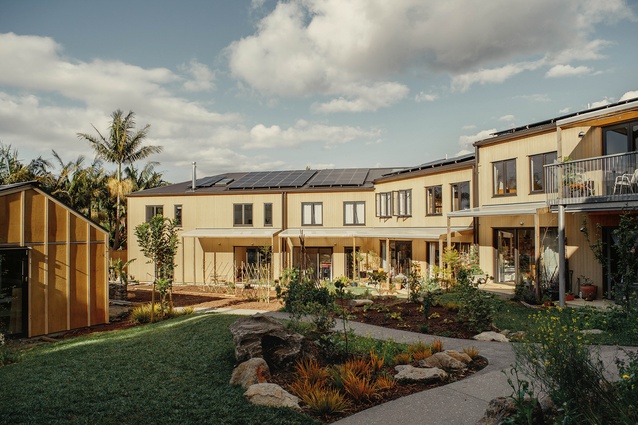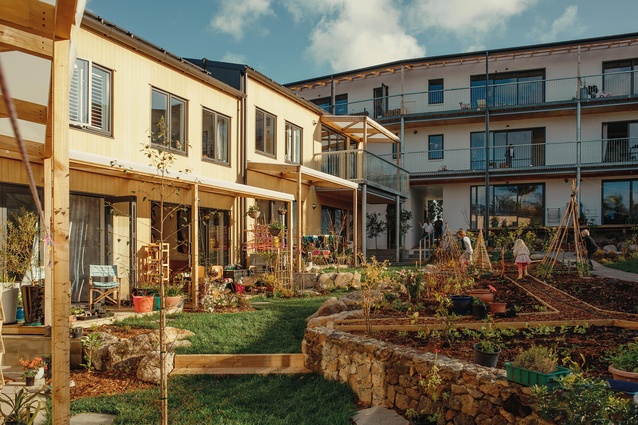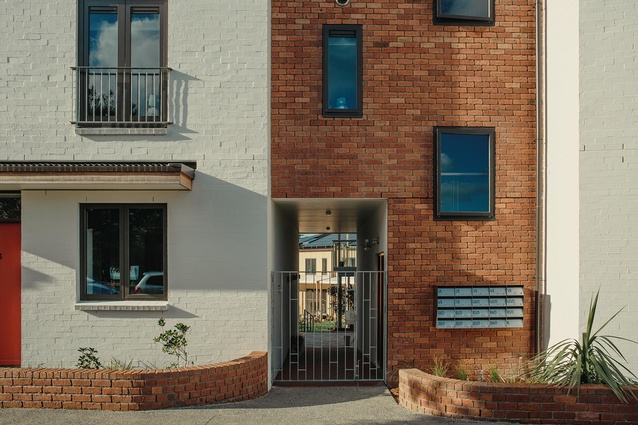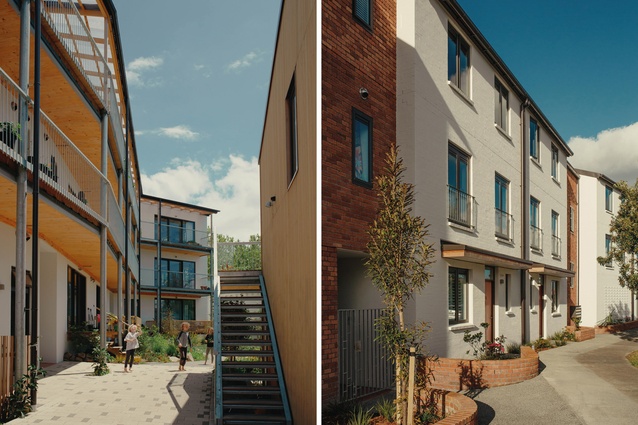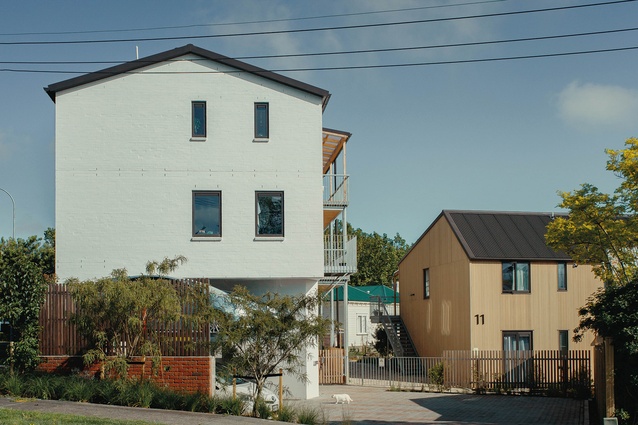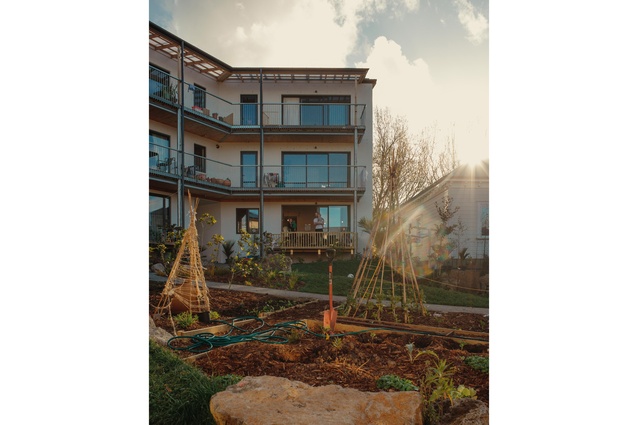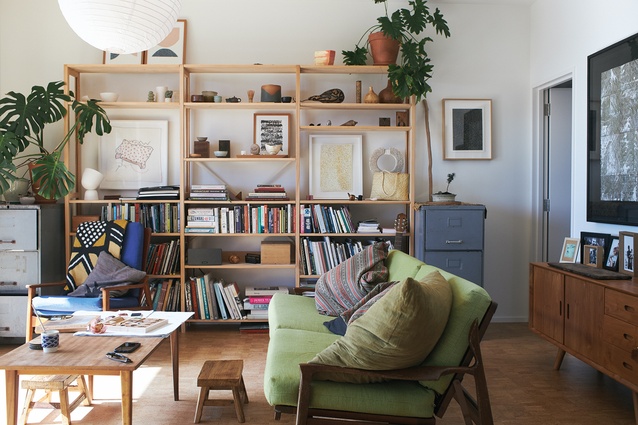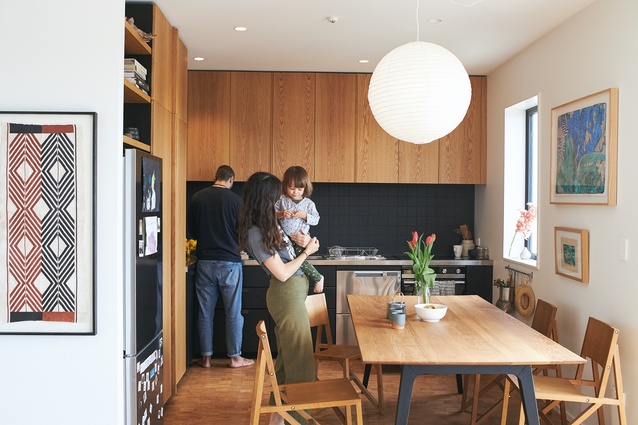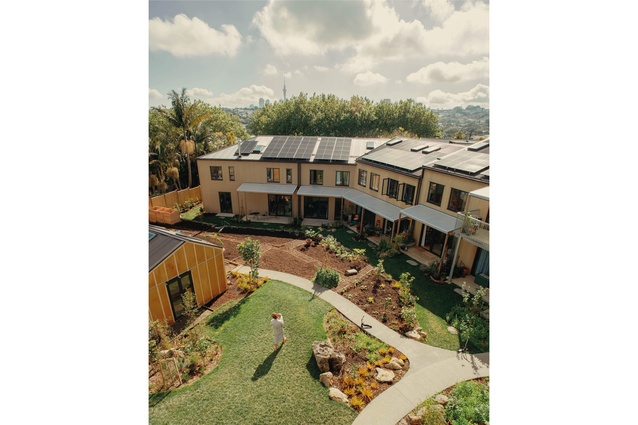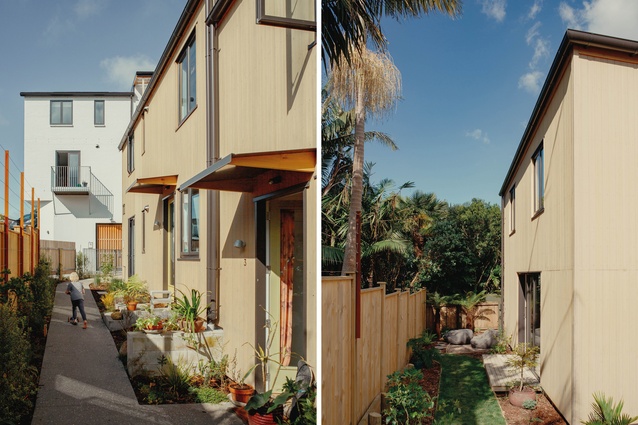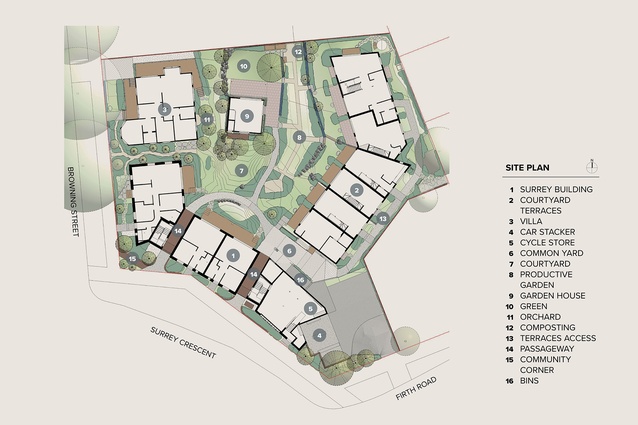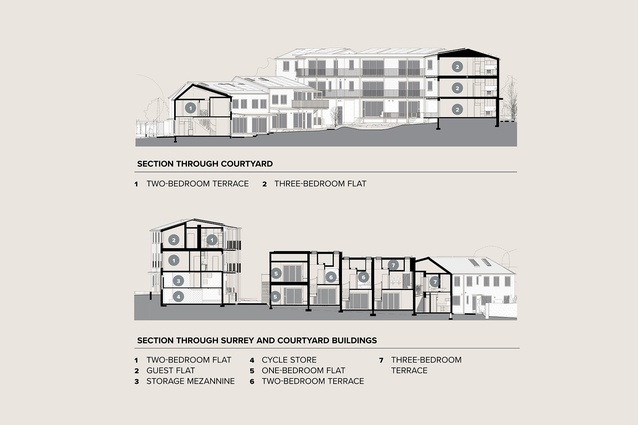Watching the collectives
From December 2019 to March 2021, the value of New Zealand’s housing stock increased by $324 billion or about $65K per person in our team of five million. Christopher Kelly looks to Greek philosopher Epictetus for a clue for managing this careening inequality, asking what we can control. You can choose your mates, he says, and that’s exactly what 20 Auckland families did to put the Surrey Crescent Cohaus together, showing the path to a new standard in affordability.
Thom Gill and Helle Westergaard of Studio Nord architects were one of the two lead ‘driver families’ (DFs) who funded the $4.95-million purchase of the land, the design and the Resource Management Act planning process, and formed a consultative development company for the four-year Cohaus Grey Lynn build.
The DFs required some serious intestinal fortitude, high levels of financial nous and professional skill, a sensitivity to the group’s requirements and an ongoing commitment to and faith in each other – a radical array of skills that they freely admit evolved during the project. On the way, they developed a grudging admiration for the risk resilience of developers and an understanding of the finely poised balance between success and failure.
Both DFs were biking families. After initially exploring smaller sites, they expanded their search to include 1900–2500m2 sites that could accommodate 12–20 units and were within a comfortable 30-minute cycling range of the city. Initially, they joined with “two or three dead-keen people with a common will” and looked for people they “knew a bit, who were prepared to go on a big journey and discover new ground on the way”. To give the community a chance of working together, the Cohaus group wanted to include people of a range of ages, gathering insights as they went into an ideal scale and mix. There was no trouble assembling a list of would-be purchasers; “five might not be enough, 40 would be too many, but we could have sold 100 two-bedders”. Middle-aged women, apparently, were more insightful about the social benefits of co-housing than the men.
An initial QS project estimate of $8.28 million (including fit-out, site works, 10 per cent contingency and GST) was interrogated by the DFs and considered during their anecdotal discussions with banks, real estate agents and other developers. They then felt comfortable giving prospective participants a target price point of $750K for a two-bed 73m2 unit, including the common property assets. The final built cost was $850K.
The first commitment for the group was signing the Development Agreement (DA). “At that point, we had a firm scheme plan that was moving through Resource Consent. This gave households a legal ownership in the project and made everyone jointly liable before we went unconditional on the site.” The company (not GST-registered) was owned by 20 separate trusts: one for each unit that provided the required 20 per cent deposit. The combined deposits became the working capital for the company. Weekly Oversight Committee meetings and monthly group meetings with the wider collective were held and each household participated in the design of its unit to individualise elements within typical unit typologies.
The second commitment was the signing of a Group Agreement (GA), which set out the organisation/governance structure sufficient to apply for the construction loan from Kiwibank and procure the main building contract. After the DA and before starting the build, the group lost four households at different times and for different reasons. They were replaced with new households.
The development process
After missing out on a couple of sites and with their eye on Grey Lynn, the DFs built up community support by talking with the nearby primary school, Kiwibank, Grey Lynn 2030, the Residents Association, Ockham, Kāinga Ora and the Waitematā Local Board. They also organised a local mail drop, information stalls at the Farmers Market and an open Q+A evening for locals, to which only opponents turned up.
They watched and learned how the developers, with their pre-arranged finance and big-picture market experience, courted the agents. Finally, thanks to cultivating their own friendly agent, they were given ‘the inside lane’ to negotiate directly with an owner. The land cost of $2446/m2 was more than budgeted and they negotiated an extended nine-month settlement to allow time to gain Planning Consent.
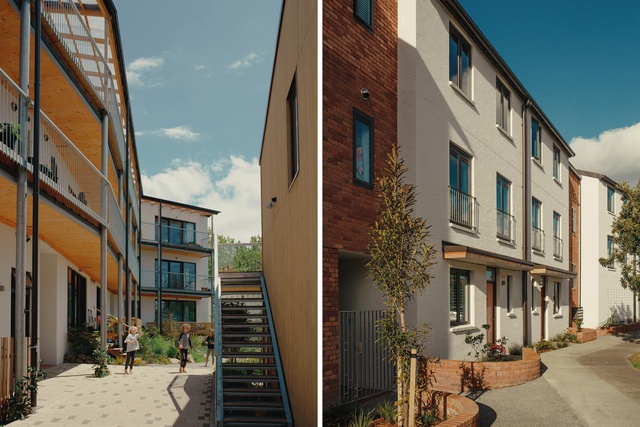
After the site was purchased, Studio Nord sustainably reused the old Maternity and Adoption Centre’s listed villa by moving it to the edge of the site to stitch Cohaus into the Browning Street heritage neighbourhood. Surprisingly, this refurbished dwelling was the hardest one to sell. The architects then added a two-storey terrace type and a three-storey apartment ‘walk-up’ around the three boundaries in which to fit their 20 units (and attain approximately 200 dwelling/hectare density). The dwellings enclose a large, sheltered garden, sloping away to the north from the busy ridge-top arterial road. “The development includes a mix of units, each with between one and four bedrooms, and residents range from single adults to families of five,” explains Gill. “All units were designed to be light-filled, compact homes with dual aspects, providing above-code thermal and sound insulation and large external decks protected from the rain.”
There were two major cost shocks along the way. Firstly, Kiwibank required the appointment of an independent project manager who organised an extensive pre-qualification builder list for tender. The builders’ tender estimates received were 25 per cent higher than the QS estimate. They interviewed the builders offering the best two prices and selected a preferred one at $10.56 million, whom they then paid extra to collaborate on a six-week intensive value engineering negotiation with the architects. Together, they pulled 10 per cent out of the cost. The GA group then signed a fixed-price construction contract for $9.24 million, excluding kitchens, fittings, landscaping, garden house and contingency.
The second price shock, to test further the resilience of the registered co-housers, was the Kiwibank requirement to hold a 7.5 per cent site contingency (instead of the 5.0 per cent previously advised) on top of the agreed lump sum price. The builder completed within two months of the programmed date and, once the Code of Compliance was granted, each household trust drew down its own mortgage and paid its balance owing in full for its title at the price agreed in the DA to clear the development company’s $27-million loan overdraft with Kiwibank.
The total cost was $19.9 million, including land, consultants, consents, construction and GST. Overall, they built 1920m2 of gross floor for $12,364/m2.
The planning context
Despite this density relaxation, the Council remained insistent that Studio Nord’s unfussy, European-inspired walk-up block had to comply fully with the two-storey planning setbacks on the busy Surrey Crescent road boundary. This was an anomaly, given the two 16m-high, five-storey residential blocks across the road.
The site is located on the boundary between two zones: a “mixed-use”, five-storey zone and a “single house with Special Character overlay” two-storey zone. Inflexibility in the Unitary Plan makes no allowance for any ‘transitional zoning’, which would permit an intermediate range of urban scale and grain.
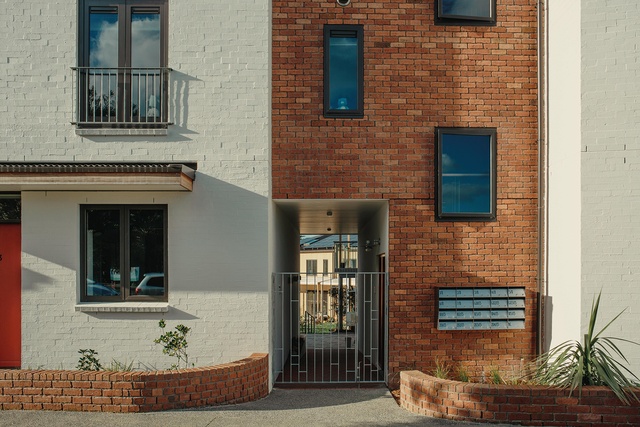
Over the nine-month period, the DFs unsuccessfully submitted two further design iterations to incorporate an additional storey but were forced to go unconditional on the land purchase without planning permission. Sixteen units, instead of the planned 20, would have resulted in a significant cost increase per participant and, eventually, at the Planning Committee hearing, Nord’s argument for three-storey living was accepted. Given the solar orientation meant height shading impacted only the main road, rather than any adjacent houses, the site could have effortlessly accommodated a four-to-five-storey ‘residential wall’ along the roadside boundary.1
The CoHoHui, organised by Victoria University in Wellington in June 2021, advocated for an urgently needed Independent Collective Housing Agency to provide guidance for risk-averse planners and expand council options for non-profit housing. Also, they lobbied the Government to allocate land that is not contestable in the open market to provide perpetually affordable housing options for Cooperatives and Community Land Trusts.
Common property assets
Cohaus developed an integrated passive design with an energy-management system that distributes low-cost power, hot water and internet to all units. Standard industry engineering assessed the maximum electrical demand at 250 amps. So far, the project draws about 85 amps, which meant a proposed new $150K site transformer was not required. A solar PV system, funded by borrowing, is to be repaid over seven years from the power rate charged by the Body Corporate to each unit. Cohaus’s energy tour de force was recognised by the 2021 Sustainable Electricity Association of New Zealand (SEANZ) award for Best Environmental Impact, with its consultant Re/volve Energy winning the Innovation Award.
It is a badge of honour for cooperatives to provide a long list of shared facilities – a tick box of incentives to join, maybe. To stay on budget, the Cohaus amenities were trimmed to:
- a guestroom with en suite – reducing the need for each unit to include a spare room
- a large common laundry and clothes line
- cultivated and uncultivated central green space.
I can’t help feeling that this enforced frugality and doing less might have better served the space and its occupants. However, the additional contingency sum left over from the ‘Kiwibank price shock’ was used to reinstate the full list of common assets in the order of priority agreed by the group:
- addition of a mezzanine to the high-bay storage
- kitting out the 35-bike shed
- purchase of two EV and four hybrid share cars and a car stacker
- landscape budget expansion (from $50K to $200K) for a richer mix of cultivated and uncultivated green space
- construction of a green ‘common hall’ for gatherings of the whole community.
Collective living
Residential buildings make up 70 per cent of a city. Good residential design is good city design and the adoption of a more diverse New Zealand planning policy that supports the complete spectrum of profit to non-profit housing types is required.2
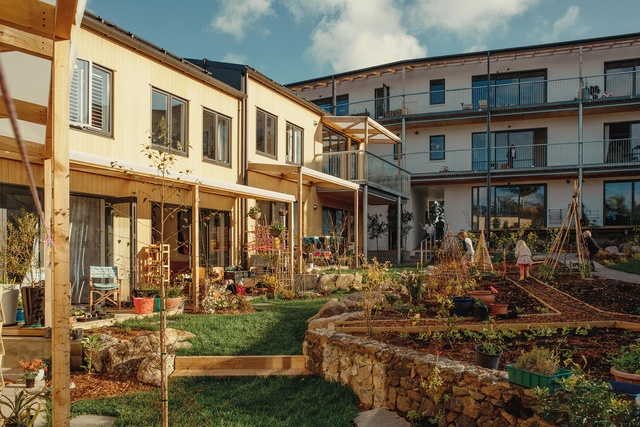
A century ago, the suburbs were radical places. The socialist ideas that initiated the discipline of town planning and the capture of value for the good of all (such as the UK’s Hampstead Gardens) were later stripped out by mass house builders who, beholden to shareholders rather than residents, applied the aesthetics rather than the ideology.At Surrey Crescent, it appears a ‘commune aesthetic’ has subconsciously crept into the exterior and the landscapers’ tendency to embroider all the ‘leftover space’ has resulted in a cluttered backyard.
The balconies and terrace houses all look inward over this crowded commons. The addition of the garden house adds further infill and reduces the park-like luxury the large site offered.3
It is, perhaps, a missed opportunity not to have positioned this much-desired gathering place over the car park on the Surrey Crescent/Firth Road corner. This would have strengthened and extended the east end of the residential roadside wall as well as offered users elevated north-east views of the Ponsonby ridge line that, otherwise, only the upper apartments enjoy.
There are cosy retreat areas in the terrace houses, especially upstairs – the result of the carefully exposed timber (CLT) floors. However, the smartly detailed steel tube balustrades on the walk-up block actually provide too much transparency to the apartments. The development hasn’t quite balanced the needs for connection and for private retreat, and the landscape and garden house placement might have helped to establish more clarity and manage the subtle distinctions between private, semi-private and shared.
It’s early days. The landscape is not established and the 47 occupants are still moving in, which is particularly commendable in itself and testament to their resolute response to Epictetus’ advice. As the June CoHoHui had tearfully recorded, quite a few collectives stall or fail.
Post-Covid, life will place increased demands on the quality of our residential infrastructure. The connectedness of people that this project enables has yet to be organised into larger bubbles. There is untapped potential for more extensive support networks during Covid lockdown – for instance, with childcare.
Wider recognition of Aotearoa’s rich tangata whenua history and further development of modern papakāinga and their ecological interconnectedness will help collate a library of local collective typologies to complement the international precedents that architects traditionally research. Cohaus’ high-density development is a worthy addition to this resource and will grow into its place as an enduring Auckland exemplar of antipodean collective living.
Read a response to this review from the Cohaus design team and residents here
1 The 1970 Ralph Erskine-designed six-storey Byker Wall in Newcastle upon Tyne, UK, has aged well and is still a valid precedent.
2 See Andy Fergus’ ‘Redesigning the Housing Market’ diagram in ‘First THAB off the rank’, architecturenow.co.nz/articles/first-thab-off-the-rank/.
3 I’m imagining a calm, light-dappled orchard over wild long grasses, like the Sissinghurst Castle Garden in the UK.

